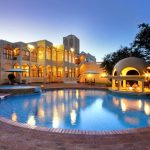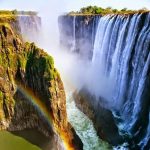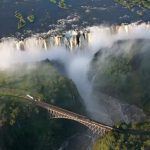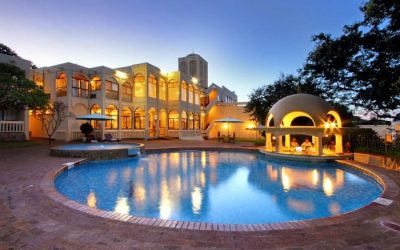Imagine standing at the edge of one of the world’s most breathtaking natural wonders, Victoria Falls. As your eyes take in the majestic beauty of the water cascading down with immense power, you can’t help but wonder about the weather in this awe-inspiring location. Will it be scorching hot, making you yearn for a refreshing mist from the falls? Or will you need to bundle up in layers to combat the chilly air? In this article, we will explore the weather conditions that grace Victoria Falls, giving you a glimpse into what Mother Nature has in store for those lucky enough to witness this marvel of the natural world. Victoria Falls, located on the border of Zimbabwe and Zambia, experiences a unique climate that is characterized by distinct wet and dry seasons. The weather in Victoria Falls can greatly impact your travel plans, so it is important to understand the different seasons and what to expect during your visit. From the scorching summers to the mild winters, each season offers a different experience, making Victoria Falls a year-round destination for travelers.
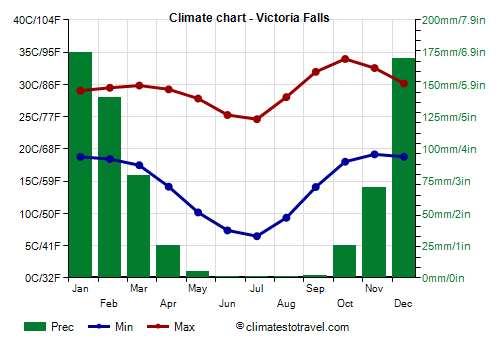
Seasons in Victoria Falls
Victoria Falls experiences four distinct seasons: Summer, Autumn, Winter, and Spring. Each season has its own characteristics and brings different weather patterns to the area.
Summer (November – March)
Summer in Victoria Falls is from November to March and is characterized by high temperatures and heavy rainfall. During this season, the average temperature ranges from 25°C to 35°C (77°F to 95°F), making it the hottest time of the year. The rainfall during summer is quite heavy, with frequent afternoon showers and thunderstorms that can last for hours. These downpours contribute to the rise of humidity levels, creating a tropical and lush landscape around the falls.
Autumn (April – May)
Autumn in Victoria Falls, from April to May, brings relief from the scorching temperatures of summer. The average temperature drops slightly to a range of 20°C to 30°C (68°F to 86°F). The rainfall also begins to reduce during this season, leading to fewer showers and more sunny days. Autumn is a beautiful time to visit Victoria Falls, as the vegetation is still vibrant from the previous summer rains.
Winter (June – August)
Winter in Victoria Falls occurs from June to August and is characterized by mild temperatures and little to no rainfall. The average temperature drops to a range of 10°C to 25°C (50°F to 77°F), creating pleasant weather for outdoor activities. Although it is winter, the climate in Victoria Falls remains relatively warm compared to other parts of the world. Clear skies and cooler temperatures make this season popular for wildlife viewing and various water-based activities.
Spring (September – October)
Spring in Victoria Falls, from September to October, marks the transition from winter to summer. The average temperature rises again to a range of 20°C to 30°C (68°F to 86°F), and the rainfall starts to increase. Spring is considered one of the best times to visit Victoria Falls, as the weather is mild and the landscape is lush and green after the winter months.
Temperature in Victoria Falls
Understanding the temperature patterns in Victoria Falls is essential for planning your activities and deciding when to visit.
Average temperature
The average temperature in Victoria Falls varies throughout the year. Summer sees the highest temperatures, with averages ranging from 25°C to 35°C (77°F to 95°F). Autumn and spring offer milder temperatures, ranging from 20°C to 30°C (68°F to 86°F), while winter brings cooler temperatures ranging from 10°C to 25°C (50°F to 77°F).
Hottest months
The hottest months in Victoria Falls are typically during the summer season, from November to March. December and January are particularly hot, with temperatures reaching their peak and often exceeding 35°C (95°F). It is important to stay hydrated and take necessary precautions to protect yourself from the intense heat during this time.
Coldest months
The coldest months in Victoria Falls occur during the winter season, from June to August. Although the temperatures are relatively mild compared to other parts of the world, the average temperature during this period ranges from 10°C to 25°C (50°F to 77°F). It is advisable to pack a light jacket or sweater for the cooler mornings and evenings during these months.
Rainfall in Victoria Falls
Rainfall in Victoria Falls is a significant factor in the region’s climate and plays a vital role in shaping the landscape and overall experience.
Annual rainfall
Victoria Falls receives a significant amount of rainfall throughout the year, with an average annual precipitation of around 1,100 millimeters (43 inches). The majority of the rainfall occurs during the summer season, from November to March, when heavy downpours and thunderstorms are common. During this period, the Zambezi River swells, resulting in the magnificent spectacle of the Victoria Falls in full flow.
Wet season
The wet season in Victoria Falls coincides with the summer months of November to March. This period experiences the highest amount of rainfall, with frequent showers and thunderstorms. The heavy downpours create a lush and green environment, adding to the beauty of the falls and the surrounding wildlife.
Dry season
The dry season in Victoria Falls occurs from April to October, with minimal rainfall. During this period, the water levels of the Zambezi River decrease, and the falls may appear less impressive compared to the wet season. However, the dry season offers its own advantages, such as clearer skies and easier access to certain activities.
Humidity in Victoria Falls
Humidity levels in Victoria Falls are influenced by the region’s proximity to water sources, such as the Zambezi River and the Victoria Falls themselves.
Humidity levels
Due to its tropical climate, Victoria Falls experiences relatively high humidity levels throughout the year. The humidity is most noticeable during the wet summer months, with levels ranging from 50% to 85%. The combination of high temperatures and humidity can make it feel even hotter, so it is important to stay hydrated and take breaks to avoid heat exhaustion.

Wind in Victoria Falls
The wind patterns in Victoria Falls can have a significant effect on the overall weather experience and outdoor activities.
Windspeed
Windspeed in Victoria Falls tends to be moderate throughout the year, with average speeds ranging from 10 to 20 kilometers per hour (6 to 12 miles per hour). However, gusts of wind can be stronger, especially during thunderstorms. It is important to be cautious when participating in water-based activities during windy conditions.
Prevailing wind direction
The prevailing wind direction in Victoria Falls is generally northeast, influenced by the Zambezi River. The cool breezes from the river provide some relief from the heat, particularly during the hot summer months. However, wind patterns can vary, and it is always advisable to check weather forecasts before planning outdoor activities.
Sunshine in Victoria Falls
The amount of sunshine in Victoria Falls greatly influences the duration of daylight hours and the overall experience of the destination.
Daylight hours
Victoria Falls experiences fairly consistent daylight hours throughout the year, with variations corresponding to the changing seasons. The longest daylight hours occur during the summer months, from November to February, with approximately 12 to 13 hours of daylight. In contrast, the shortest daylight hours occur during the winter months, from June to August, with approximately 10 to 11 hours of daylight. It is important to consider these variations when planning outdoor activities and sightseeing.
Sunshine hours
Victoria Falls enjoys a significant amount of sunshine throughout the year, with an average of 8 to 10 hours of sunshine per day. During the dry season, from April to October, the skies are often clear, allowing for ample sunshine. The abundance of sunshine provides ideal conditions for wildlife viewing, outdoor adventures, and exploring the magnificent Victoria Falls.

Climate in Victoria Falls
The climate in Victoria Falls is classified as tropical, characterized by distinct wet and dry seasons.
Tropical climate
Victoria Falls experiences a tropical climate, which means it is generally warm to hot throughout the year. The region receives a significant amount of rainfall, particularly during the summer months. The high temperatures and humidity contribute to the lush vegetation and stunning landscapes surrounding the falls. It is important to pack appropriate clothing and take precautions to protect yourself from the heat and humidity.
Mild winters
Winters in Victoria Falls are relatively mild compared to other parts of the world. The average temperatures range from 10°C to 25°C (50°F to 77°F) during this season. Clear skies and cooler temperatures make it an ideal time for activities such as wildlife viewing and exploring the falls without the intense heat of summer.
Hot summers
Summers in Victoria Falls are characterized by high temperatures and heavy rainfall. The average temperatures during summer range from 25°C to 35°C (77°F to 95°F), making it the hottest time of the year. The combination of heat and humidity can be quite intense, so it is important to stay hydrated and protect yourself from the sun.
Impact of Weather on Tourism
The weather in Victoria Falls plays a significant role in determining the flow of tourists and the overall tourism experience.
High tourist season
The high tourist season in Victoria Falls coincides with the dry season, from April to October. During this period, the falls are less affected by heavy rainfall and offer a clearer view of the cascading water. The dry season is also an ideal time for activities such as bungee jumping, canoeing, and game drives. It is recommended to book accommodations and activities well in advance during this peak season.
Ideal time to visit
The ideal time to visit Victoria Falls depends on personal preferences and the desired experience. If you prefer to witness the falls in full flow and experience lush surroundings, the wet season from November to March is the best time to visit. The water volume is at its peak, creating a spectacular display. On the other hand, if you prefer drier conditions and outdoor activities, the dry season from April to October is the ideal time.
Off-peak season
The off-peak season in Victoria Falls occurs during the wet summer months, from November to March. Although the falls are at their most impressive during this period, fewer tourists visit due to the high rainfall and increased humidity. The off-peak season offers the opportunity to explore the falls with fewer crowds and at a more leisurely pace.

Weather Preparation
Proper weather preparation is vital for a comfortable and enjoyable visit to Victoria Falls. From packing the right clothing to protecting yourself from the elements, adequate preparation ensures a pleasant experience.
What to pack
When visiting Victoria Falls, it is essential to pack appropriate clothing and essentials based on the season. Lightweight and breathable clothing is recommended for the hot summer months, along with a wide-brimmed hat, sunglasses, and sunscreen. In the cooler winter months, it is advisable to pack a light jacket or sweater for the cooler mornings and evenings. Comfortable walking shoes and insect repellent are also essential items to pack for exploring the falls and surrounding areas.
Protecting against heat
The high temperatures and humidity during the summer months can be challenging to handle. To protect yourself from the heat, it is important to stay hydrated by drinking plenty of water throughout the day. Wearing lightweight and light-colored clothing can also help to reflect the sun’s rays and keep you cooler. Additionally, taking breaks in shaded areas and avoiding exertion during the hottest parts of the day can reduce the risk of heat-related illnesses.
Rain gear
Due to the significant rainfall in Victoria Falls, especially during the summer months, it is advisable to pack rain gear such as a waterproof jacket, umbrella, and waterproof bag or cover for electronic devices. These items will help you stay dry and protect your belongings during sudden downpours or when visiting the falls.
Conclusion
Victoria Falls, with its unique climate and stunning natural beauty, offers a captivating experience throughout the year. From the roaring falls during the wet season to the clear skies of the dry season, each season brings its own charm and opportunities for exploration. By understanding the weather patterns, temperature variations, and the impact on tourism, you can plan your visit to Victoria Falls accordingly and ensure a memorable and enjoyable experience. Remember to pack appropriate clothing, protect yourself from the elements, and make the most of the diverse activities and attractions that Victoria Falls has to offer.




